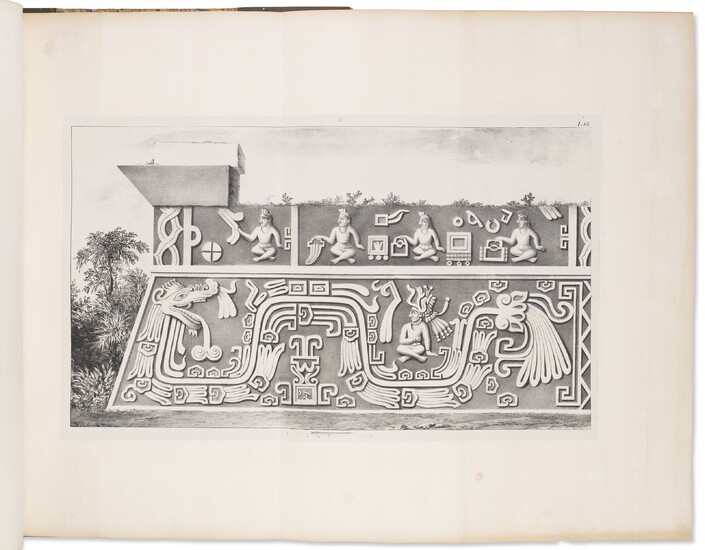Antiquities of Mexico
KINGSBOROUGH, Edward King, Viscount (1795-1837). Antiquities of Mexico: comprising fac-similes of ancient Mexican paintings and hieroglyphics. London: A. Aglio, 1830 [vols I-V]; Robert Havell, Colnaghi Son and Co., 1831 [vols VI-VII]; and Henry G. Bohn, 1848 [vols VIII-IX].
First edition of one of the greatest illustrated works on Mexican antiquities (and their conspiracy theories). The first issue of vols I-V, with titles dated 1830 and Augustine Aglio as publisher. The story of Kingsborough’s fateful obsession with Mexican manuscripts is well known: during his studies at Oxford he became fascinated by one of the Bodleian's manuscripts—the very one described by Samuel Purchas in volume III of his 1626 Purchas his Pilgrimes—and decided to devote himself to the study of Central American manuscripts and artifacts, producing a publication that would ultimately cost him his fortune as well as his life.
The immense resulting project was an incredible contribution to the dissemination of the visual history of the Yucatan. Unfortunately, however, Kingsborough was also convinced of the pseudo-scientific idea that the civilizations of ancient Mesoamerica were a lost tribe of Israel, and his text is full of elaborate fantasies about the ancient connections between the Maya and the ancient Mediterranean, many of which still live on today in the stranger corners of the internet. In order to create his magnum opus, he hired the Italian artist Augustine Aglio to copy the Mexican manuscripts held in European libraries and private collections, including those of Sir Thomas Phillipps. Antiquities of Mexico also contains the first publication of the findings of Dupaix and Castañeda—which notably refute the Lost Tribes of Israel and other pre-Columbian contact theories.
Kingsborough died in 1837 of typhus contracted in prison in Dublin, a few days after being arrested for a debt to a paper manufacturer. As stated on the titles of vols I-VII, the work was intended to contain seven volumes; the last two volumes were published by Bohn in 1848 as a supplement based on the author’s notes. In 1831 Aglio transferred the stock of all seven volumes to Havell and Colnaghi, who printed new title pages with their address and the current date. Copies like the present one that retain the original title pages are uncommon. Brunet III, 663; Lipperheide Md11; Palau 128006; Sabin 37800.
Nine volumes, folio (540 x 367mm). 742 uncolored lithographs, some mounted on india proof paper, a few folding (occasional light toning and foxing; titles of some volumes a little creased, flyleaf in vol 1 torn). 19th-century green half morocco over marbled boards by J. Wright (a little wear at extremities, some corners showing). Provenance: American Antiquarian Society (blindstamps on title pages with "sold by AAS" counterstamps; bookplate noting gift of Isaac David).
View it on
Sale price
Estimate
Time, Location
Auction House
KINGSBOROUGH, Edward King, Viscount (1795-1837). Antiquities of Mexico: comprising fac-similes of ancient Mexican paintings and hieroglyphics. London: A. Aglio, 1830 [vols I-V]; Robert Havell, Colnaghi Son and Co., 1831 [vols VI-VII]; and Henry G. Bohn, 1848 [vols VIII-IX].
First edition of one of the greatest illustrated works on Mexican antiquities (and their conspiracy theories). The first issue of vols I-V, with titles dated 1830 and Augustine Aglio as publisher. The story of Kingsborough’s fateful obsession with Mexican manuscripts is well known: during his studies at Oxford he became fascinated by one of the Bodleian's manuscripts—the very one described by Samuel Purchas in volume III of his 1626 Purchas his Pilgrimes—and decided to devote himself to the study of Central American manuscripts and artifacts, producing a publication that would ultimately cost him his fortune as well as his life.
The immense resulting project was an incredible contribution to the dissemination of the visual history of the Yucatan. Unfortunately, however, Kingsborough was also convinced of the pseudo-scientific idea that the civilizations of ancient Mesoamerica were a lost tribe of Israel, and his text is full of elaborate fantasies about the ancient connections between the Maya and the ancient Mediterranean, many of which still live on today in the stranger corners of the internet. In order to create his magnum opus, he hired the Italian artist Augustine Aglio to copy the Mexican manuscripts held in European libraries and private collections, including those of Sir Thomas Phillipps. Antiquities of Mexico also contains the first publication of the findings of Dupaix and Castañeda—which notably refute the Lost Tribes of Israel and other pre-Columbian contact theories.
Kingsborough died in 1837 of typhus contracted in prison in Dublin, a few days after being arrested for a debt to a paper manufacturer. As stated on the titles of vols I-VII, the work was intended to contain seven volumes; the last two volumes were published by Bohn in 1848 as a supplement based on the author’s notes. In 1831 Aglio transferred the stock of all seven volumes to Havell and Colnaghi, who printed new title pages with their address and the current date. Copies like the present one that retain the original title pages are uncommon. Brunet III, 663; Lipperheide Md11; Palau 128006; Sabin 37800.
Nine volumes, folio (540 x 367mm). 742 uncolored lithographs, some mounted on india proof paper, a few folding (occasional light toning and foxing; titles of some volumes a little creased, flyleaf in vol 1 torn). 19th-century green half morocco over marbled boards by J. Wright (a little wear at extremities, some corners showing). Provenance: American Antiquarian Society (blindstamps on title pages with "sold by AAS" counterstamps; bookplate noting gift of Isaac David).



